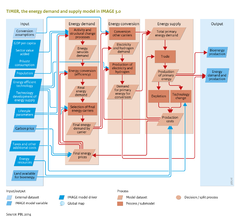Energy supply and demand: Difference between revisions
Jump to navigation
Jump to search
No edit summary |
No edit summary |
||
| Line 16: | Line 16: | ||
The IMage Energy Regional model, also referred to as [[TIMER model|TIMER]], has been developed to explore scenarios for the energy system in the broader context of the IMAGE global environmental assessment framework ([[De Vries et al., 2001]]; [[Van Vuuren, 2007]]). TIMER describes 12 primary energy carriers in 26 world regions and is used to analyse long-term trends in energy demand and supply in the context of the sustainable development challenges<ref>The words energy demand and energy use are often used interchangeably. However, in the past data were about statistical energy use. For the future, trends were extrapolated and denoted as energy demand, which in the model is assumed to be fully supplied and thus equal to use.</ref>. The model simulates long-term trends in energy use, issues related to depletion, energy-related greenhouse gas and other air polluting emissions, together with land-use demand for energy crops. The focus is on dynamic relationships in the energy system, such as inertia and learning-by-doing in capital stocks, depletion of the resource base and trade between regions. | The IMage Energy Regional model, also referred to as [[TIMER model|TIMER]], has been developed to explore scenarios for the energy system in the broader context of the IMAGE global environmental assessment framework ([[De Vries et al., 2001]]; [[Van Vuuren, 2007]]). TIMER describes 12 primary energy carriers in 26 world regions and is used to analyse long-term trends in energy demand and supply in the context of the sustainable development challenges<ref>The words energy demand and energy use are often used interchangeably. However, in the past data were about statistical energy use. For the future, trends were extrapolated and denoted as energy demand, which in the model is assumed to be fully supplied and thus equal to use.</ref>. The model simulates long-term trends in energy use, issues related to depletion, energy-related greenhouse gas and other air polluting emissions, together with land-use demand for energy crops. The focus is on dynamic relationships in the energy system, such as inertia and learning-by-doing in capital stocks, depletion of the resource base and trade between regions. | ||
Similar to other IMAGE components, TIMER is a simulation model. The results obtained depend on a single set of deterministic algorithms, according to which the system state in any future year is derived entirely from previous system states. In this respect, TIMER differs from most macroeconomic models, which let the system evolve on the basis of minimising cost or maximising utility under boundary conditions. As such, TIMER can be compared to energy simulation models, such as POLES ([[Criqui et al., 2003]]) and GCAM ([[Thomson et al., 2011]]). | Similar to other IMAGE components, TIMER is a simulation model. The results obtained depend on a single set of deterministic algorithms, according to which the system state in any future year is derived entirely from previous system states. In this respect, TIMER differs from most macroeconomic models, which let the system evolve on the basis of minimising cost or maximising utility under boundary conditions. As such, TIMER can be compared to energy simulation models, such as [[POLES model|POLES]] ([[Criqui et al., 2003]]) and [[GCAM model|GCAM]] ([[Thomson et al., 2011]]). | ||
<references/> | <references/> | ||
==Overview of TIMER | ==Overview of TIMER= | ||
The energy model has three components: energy demand; energy conversion; and energy supply (see flowchart). The energy demand component describes how energy demand is determined for five economic sectors -industry, transport, residential, services and other sectors. The energy conversion components describes how carriers such as electricity and hydrogen are produced. Finally, the energy supply modules describe the production of primary energy carriers, and calculate prices endogenously for both primary and secondary energy carriers that drive investment in the technologies associated with these carriers. The energy flows in all three main components allow calculation of greenhouse gas and air pollutant emissions. | The energy model has three components: energy demand; energy conversion; and energy supply (see flowchart). The energy demand component describes how energy demand is determined for five economic sectors -industry, transport, residential, services and other sectors. The energy conversion components describes how carriers such as electricity and hydrogen are produced. Finally, the energy supply modules describe the production of primary energy carriers, and calculate prices endogenously for both primary and secondary energy carriers that drive investment in the technologies associated with these carriers. The energy flows in all three main components allow calculation of greenhouse gas and air pollutant emissions. | ||
Revision as of 11:49, 22 May 2014
|
Composition of Energy supply and demand Additional info |
| Component is implemented in: |
|
| Projects/Applications |
| Models/Databases |
| Key publications |
| References |
Description of Energy supply and demand
